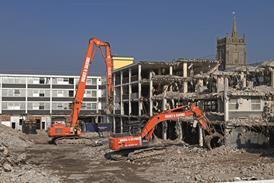Why should investors put their money into regeneration projects?
Public eye: Jackie Sadek
Let's be honest. to those not in the know the word "regeneration" has always seemed just a little bit worthy, conjuring up visions of ideal, gentrified streets and urban community centres. For big investors, it must seem a million miles away from the racy world of property development.
For more than the two decades I've worked in regeneration, pioneers have been trying to prove that mixed-use schemes create a better rate of return than straightforward property development. However, that message has never got across to developers and funders.
When I was at Stanhope in the mid-1980s, I ran a seminar that dared to ask senior investors why they did not invest in mixed-use developments. The response came that nobody ever presented them with mixed-use developments for funding. More galling still was the industry's response to this answer, which was along the lines that they never present mixed-use developments for funding because it was common knowledge that they developments never get funding …
For the most part we have the same Catch-22 situation today as we had back then. Our macho stand-off has become a self-fulfilling prophesy. Of course, various reasonable-sounding reasons for not investing are also bandied about - it's too high risk or too complex.
Satisfyingly, English Partnerships have blown the "too high risk" myth out of the water. Their research has demonstrated that commercial properties in regeneration areas often have a better long-term rate of return than ordinary property development schemes, and at the very least perform broadly in line with them.
EP has blown the ‘too high risk’ myth out of the water
As for being too complex, that smacks of industry prejudice rather than the truth. As a well known property figure is apt to say, "if you want to look forward, talk to a developer, if you want to look backward, talk to an agent". The banking institutions are advised by surveyors from the big agency firms, and are therefore risk-averse and backward looking in outlook. Not that you can blame people for playing it safe - nobody ever went broke with that strategy. Nobody ever made a real difference, either.
But the climate is changing, and investors need to be primed for this. Future property development will entail far more creative land uses than we are accustomed to, and this means that urban regeneration schemes will become the norm, not the exception. This trend is already clear, and is even more attenuated by the current panic over the use of fossil fuels and the environmental impact of new development.
Jackie Sadek is chief executive of Park Royal Partnership
Private eye: Nick Townsend
Urban regeneration projects have always been approached with caution by the investment community. The idea of sustainable communities, campaigns against social exclusion and the minutiae of planning policy are difficult areas for institutions that judge solely on investment return.
As a result, long ago, the myth was propagated that good returns can only be made from investments in prosperous areas. I can understand the initial scepticism. The institutions, like any other investors, buy into what they know and what they can analyse. Urban regeneration had no track record, nothing that could be analysed. It was inevitable that many projects would be classified as "too risky".
Competitive tendering for projects is intense
A decade on, however, there is compelling evidence that urban regeneration projects are less risky and are capable of outperforming even the healthiest of markets. It is clear that urban regeneration is an all-too-rare confluence of private sector investment criteria and government policy - which can simultaneously offer excellent returns while helping to realise the economic and social potential of unfashionable and deprived areas.
Why then are the institutions not flocking to invest in urban regeneration projects? My view is that the institutions have become immune to government rhetoric. Let me reassure them. These schemes are not some underhand attempt to get the private sector to pay for public sector projects; they are in fact a major driver towards the creation of the sort of sustainable communities being envisaged for the 21st century. They can also prove good long-term investments.
Our experience at Wilson Bowden may also offer some comfort for the institutions that are open to the idea of investing in regeneration. Competitive tendering for regeneration projects is intense among property developers, who are well aware of the returns available if risk is properly managed.
It must also be remembered that many of the companies competing for these projects are listed companies, subject to the same requirement to create shareholder value and offer a decent return to our own investors. We would not have got involved in new urban regeneration projects in towns such as Northwich, Bolton, Wrexham and Bishop's Stortford, if these projects did not offer acceptable returns.
Institutional investors should look beyond their normal investment strategies and diversify their portfolios to include a greater element of these projects. This is no time for caution - investing in regeneration can further everyone's agenda.
Nick Townsend is a director with Wilson Bowden
Source
RegenerateLive























No comments yet